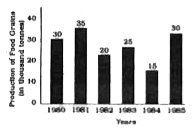A country has a food deficit of 10%. Its population ear. Its annual food production every year is 4% more than that of the last year Assuming that the average food requirement per person remains constant, prove that the country will become self-sufficient in food after n years, where n is the smallest integer bigger than or equal to loge10−loge9(loge1.04)−0.03Solution in Tamil
Let P0 be the initial population of country and P be the population of country in year t. Then,
dPdt= rate of change of population =3100P=0.03P
∴ Population of P at the end of n years is given by
∫PP0dPP=∫P00.03dt
or ∈P−lnP0=(0.03)n
or lnP=lnP0+(0.03)n.............(1)
If F0 is its initial food production and F is the food production in year n, then
F0=0.9P0
and F=(1.04)nF0
or InF=nln(1.04)+lnF0...............(2)
The country will be self-sufficient if F≥P
or lnF≥lnP
or nln(1.04)+lnF0≥lnP0+(0.03)n
or n≥lnP0−lnF0ln(1.04)−(0.3)=ln10−ln9ln(1.04)−0.03
Hence, n≥ln10−ln9ln(1.04)−0.03
Thus,the least integral values of the year n, when the country becomes self-suffcient, is the smallest integer greater than or equal to ln10−ln9ln(1.04)−0.03
Similar Questions
প্রতিবছর জনসংখ্যা 10% বৃদ্ধি হলে, n বছর পর জনসংখ্যা হয় P। n বছর পূর্বে জনসংখ্যা কত ছিল?
02:39View SolutionA country has a food deficit of 10% . Its population grows continuously at a rate of 3% per year. Its annual food production every year is 4% more than that of the last year. Assuming that the average food requirement per person remains constant, prove that the country will become self-sufficient in food after n years, where n is the smallest integer bigger than or equal to (ln10-ln9)/(ln(1.04)-0.03)
12:59View SolutionA country has a food deficit of 10%. Its population grows continuously at the rate of 3% per year. Its annual food production every year is 4% more than that of the last year Assuming that the average food requirement per person remains constant, prove that the country will become self-sufficient in food after n years, where n is the smallest integer bigger than or equal to loge10−loge9(loge1.04)−0.03
13:19View SolutionA country has a food deficit of 10%. Its population grows continuously at the rate of 3% per year. Its annual food production every year is 4% more than that of the last year Assuming that the average food requirement per person remains constant, prove that the country will become self-sufficient in food after n years, where n is the smallest integer bigger than or equal to loge10−loge9(loge1.04)−0.03
08:55View SolutionThe population of a village in the first year 5% and in the next two years 10% increased by. for some reason in the last year 4% decreased. If after a total of four years its population becomes 60984, then what was its population in the beginning?
03:32View SolutionIn a team of 10 persons, nine persons spent Rs.40 on their food and the remaining one person spent Rs.9 more than the average expenditure of all the 10 persons. What was the total expenditure on their food?
04:15View SolutionThe graph shows the production of food grains of a country in different years. Study the graph and answer the questions.

The sum of the production of food grains in the years 1982 and 1984 is equal to that in the year :02:14View Solution

